Yesterday was the 35th anniversary of the Crash of 1987. It was noted in the media but didn’t get the sort of coverage that I expected. It is likely that few wanted to be reminded of a market crash when we’re amidst a bear market. That’s OK. I will argue that the market’s craziest day was the following session. As much as Black Monday was a momentous event, what transpired the next day was far more remarkable and left a legacy that looms large to this day.
I assert that the “Fed Put” was born on around noon on October 20th, 1987.
An assertion like that requires some evidence. Mine is eyewitness testimony, but still only circumstantial at best. It starts with a bit of history. I finished the Salomon Brothers sales and trading training class in early 1987. It’s the class made famous in Liar’s Poker. I was a summer intern in 1985 (Michael Lewis’ class started as I was heading back to school) and got an offer to return full time after I graduated in May ’86. Somehow, I was able to negotiate a deal that allowed me to delay my start date for a few months. I used that time primarily to study Japanese in Tokyo and circumnavigate Australia with a backpack before returning to begin my Wall Street career.
Having travelled extensively in the prior months, I sought a position in one of the firm’s international departments. There were none available in fixed income, which was Salomon’s main profit center, so I decided to forego government bond trading for the international equity department. In those days, listed equities were traded very differently from OTC stocks, so they were organized into different desks. We divided the world by geography, however, so we needed to be able to trade ADRs in both venues. That required a few weeks of shadowing one of the firms NYSE floor brokers and learning how NASDAQ trading worked. By the summer I joined the desk full-time and almost immediately given the responsibility for trading Scandinavian ADRs and some Canadian stocks.
Because we worked closely with our counterparts in London, I got to make my first international business trip to the UK in early October. I then joined a more senior London-based colleague on a business trip to Oslo, Stockholm, Helsinki and Copenhagen with little appreciation for just how crazy it was for me to be given so much responsibility so quickly. We fortunately missed a freak UK hurricane, but could not help noticing the storm that was brewing in global equity markets.
I returned to New York on the 18th. My father picked me up at the airport (thanks Dad!) and said that I missed a crazy couple of weeks. Bear in mind that the Dow Jones Industrial Average’s largest one-day fall up to that time – in points, not percentages – was on October 16th. I said that I didn’t think it was over, and hoped I wasn’t too worn out and jet lagged to be as functional as I needed to be. I learned quickly that adrenaline is a great remedy.
It was immediately clear that trouble was brewing when I arrived before our daily 7am meeting. The FTSE 100 was plunging, partly because the hurricane prevented London markets from opening on Friday. The portfolio insurance crowd, which wasn’t serviced by our desk, were itching to sell futures as soon as we opened. Down we went, and it only got worse. My primary role that day was to make sure that we weren’t on the bid on any of our NASDAQ markets and to avoid picking up the phone. If you picked up a phone call from another NASDAQ market-maker, you had to honor your market. So few phones went answered. By the end of the day, the room was shell-shocked.
But the mood the next morning was even grimmer. In our 7am meeting we were told that the specialist system was essentially bankrupt. They were unable to meet their margin requirements, putting immense pressure on the clearinghouses and banks that financed the dealers. Those who maintained orderly markets on the NYSE were largely unable to do so.
We sank throughout the morning, and by noon equity markets had essentially come to a total halt. Most NYSE stocks were offered-only and no NASDAQ dealers weren’t answering phones. To this day we can’t really gauge how far the market had fallen, because index calculations are based upon last-sales, and there were few if any trades actually occurring. It is likely the actual index levels would have indicated a decline similar to or worse than the prior day’s. Shell-shock had morphed into a weird sense of doom.
From my desk, I could see the firm’s top management gathering in Stanley Shopkorn’s office. Stanley was the Managing Director of the equity department and rightfully regarded as a consummate trader. Through the clouds of cigar smoke, I could see what appeared to be conference calls. Occasionally, Shopkorn’s top lieutenant would yell into the office, “Stanley, it’s Mnuchin.” Robert Mnuchin, the father of the recent Treasury Secretary, was Shopkorn’s counterpart at Goldman Sachs. There may have been similar calls to or from Barton Biggs, who had that role at Morgan Stanley, but I can’t be sure.
At some point around noon, the firm’s management emerged, and Stanley made a pronouncement to the room. “Listen up. I want all you #@$% to call down to the floor of the NYSE and find out what it would take to offset any imbalances in any stock you trade. Then put in a bid for it.” It became clear that Goldman, and maybe other firms, were making similar inquiries.
We ended up buying less stock than you might expect. The mere act of major firms seeking to buy stocks caused many of the offers to cancel. The momentum had reversed, and indices closed the day higher. The financial system, which had essentially locked-up completely, seemed somewhat healthier. There was a general sense that the worst had passed, though it would take some time to clean up the debris.
Because I was not privy to the actual phone calls, I’ve never been able to say with 100% assurance that our buy program was backstopped by the Fed. The closest I could get was second hand, most notably from a friend who is a partner at a firm headed by a then-Salomon equity MD. He has asked not only his boss, but also John Gutfreund, the Salomon CEO in 1987, whether the Fed had backstopped the firm’s actions in the aftermath of the crash. My friend claims that he never got an explicit “yes”, but instead got evasive answers that implied that the Fed played a role. I don’t doubt that the traders who ran Salomon were inclined to buy the largest dip ever, but it is hard to imagine that they would have committed a potentially staggering amount of capital without a backstop.
It can hardly be a coincidences that around noon that day Fed Chairman Greenspan issued the following terse statement: “The Federal Reserve, consistent with its responsibilities as the Nation’s central bank, affirmed today its readiness to serve as a source of liquidity to support the economic and financial system.” The timing roughly coincided with the firm’s management emerging from the smoke-filled room. It is hard not to see the events as related.
But it is crucial to realize what drove the Fed to an unprecedented intervention. It wasn’t just that equities were collapsing, it was that the financial system was collapsing. If the clearinghouses and major institutions like Bank of New York were reeling, it could have quickly caused a contagion that would be difficult, if not impossible, to contain without decisive action. Plunging equity prices were the root cause of what had become a potential banking crisis. Intervening in equity markets – whether directly or by offering a backstop – was the quickest way to stabilize the problem before it metastasized.
For this reason, we wrote a reminder earlier this month that equity traders should not delude themselves into thinking that the so-called “Fed Put” will be implemented simply because stocks have fallen. Just yesterday, St. Louis Fed President Bullard said that the Fed shouldn’t react to declines in the stock market but is watching liquidity in key markets like Treasuries. The Federal Reserve will indeed intervene if credit markets or the banking system is threatened. Unless we get an event like that of Black Monday, when equity markets directly threatened the health of the larger financial system, the Fed Put is likely to go unexercised. I can’t imagine that’s what anyone would want.
We’ve long asserted that while the Fed Put is perpetual, we have no idea about its striking price. On the day following Black Monday, when it made its first appearance, the strike was somewhere close to zero.
For reference, here are some relevant charts:
Next 3:
Month of October 1987, S&P 500, US 10-Year Treasury Yields, FTSE 100

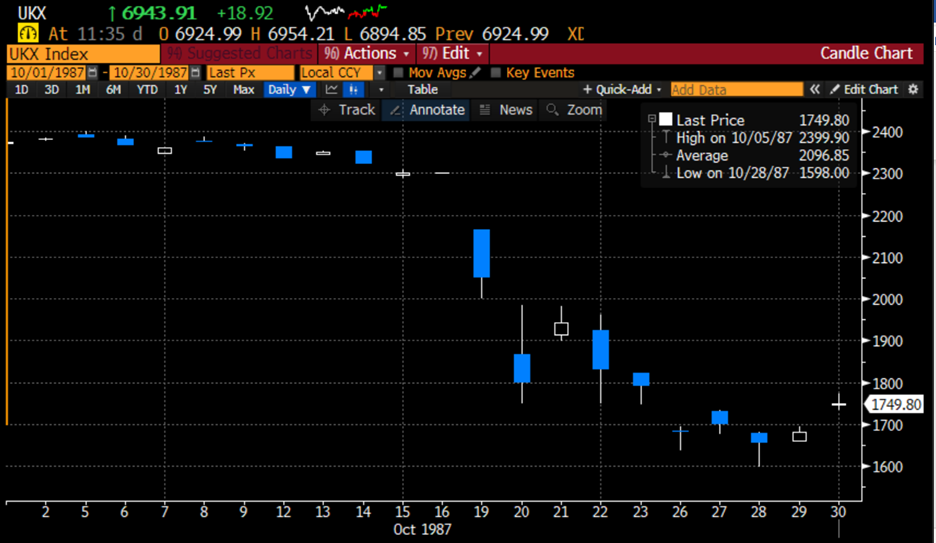
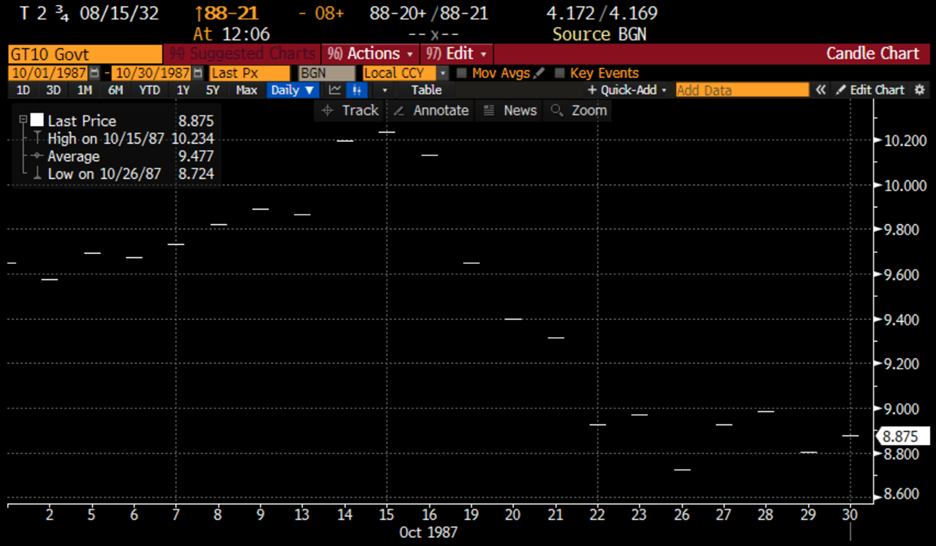
Next 3:
Year of 1987, S&P 500, US 10-Year Treasury Yields, FTSE 100


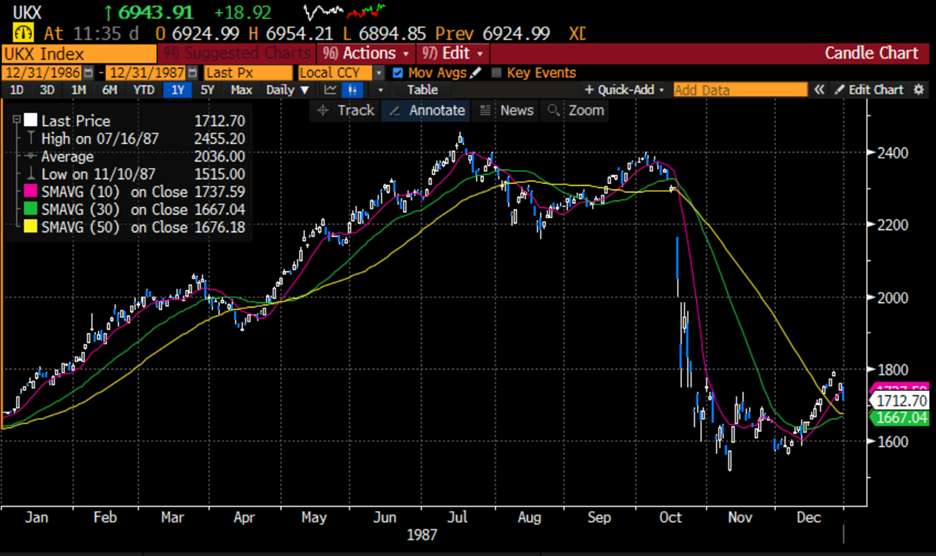
Source for all charts: Bloomberg
Disclosure: Interactive Brokers
The analysis in this material is provided for information only and is not and should not be construed as an offer to sell or the solicitation of an offer to buy any security. To the extent that this material discusses general market activity, industry or sector trends or other broad-based economic or political conditions, it should not be construed as research or investment advice. To the extent that it includes references to specific securities, commodities, currencies, or other instruments, those references do not constitute a recommendation by IBKR to buy, sell or hold such investments. This material does not and is not intended to take into account the particular financial conditions, investment objectives or requirements of individual customers. Before acting on this material, you should consider whether it is suitable for your particular circumstances and, as necessary, seek professional advice.
The views and opinions expressed herein are those of the author and do not necessarily reflect the views of Interactive Brokers, its affiliates, or its employees.
















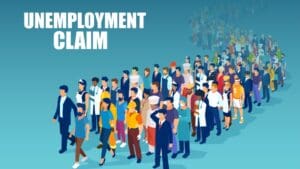


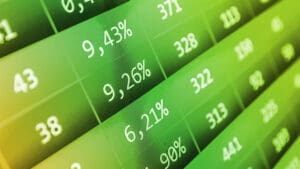
Join The Conversation
For specific platform feedback and suggestions, please submit it directly to our team using these instructions.
If you have an account-specific question or concern, please reach out to Client Services.
We encourage you to look through our FAQs before posting. Your question may already be covered!